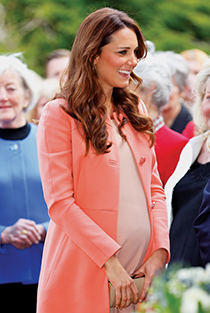The biggest celebrity baby in history?
Kate and William’s child will be the first royal baby to be born into the age of social media. #goodluck
Max Mumby/IndIgo/Getty
Share

Earlier this year, Booker Prize winner Hilary Mantel compared our collective obsession with royal breeding habits to a visit to the zoo. “Our current royal family doesn’t have the difficulties in breeding that pandas do,” she observed, “but pandas and royal persons alike are expensive to conserve and ill-adapted to any modern environment . . . Some people find them endearing; some pity them for their precarious situation; everybody stares at them and, however airy the enclosure they inhabit, it’s still a cage.”
Mantel’s bitterly funny analogy has since taken hold in the collective consciousness of Britain—a nation simultaneously obsessed by, and sick to death of, its own royal family and the lavish amounts of public money and media attention it receives. And with the duchess’s mid-July due date now out, the country is bracing itself for a cold, sodden summer of all-out royal-infant-gawking madness. Guardian style columnist Hadley Freeman recently complained that this national “panda watch” will culminate in an unprecedented deluge of pregnancy/baby/mothering stories in an already bump-glutted media. “I don’t think a day has gone by since the royal pregnancy was announced that I have not been contacted by some desperate outlet either telling me what they reckon the royal baby will be named as ascertained by their iron-clad scientific methods, or asking me if I would like to add my tuppence to the national debate swirling around Kate Middleton’s maternity wardrobe.”
The anticipation—and uncertainty—is mounting. But if the Windsors are known for one thing, it’s their fondness for mapping things out in advance. Official engagements are planned years ahead and down to the tiniest detail. But babies, as Kate joked to reporters earlier this year, “have their own agenda.” While palace officials have not confirmed a due date apart from saying the baby is expected in July, the tabloids have widely reported that “friends of the couple” are specifying July 13. As a consequence, the baby’s would-be scheduled entrance falls smack in the middle of the Coronation Festival, a four-day celebration to mark 60 years since the Queen was crowned.
As formal festivities take place in the Buckingham Palace gardens, Kate might well be under the care of royal gynecologists in the private Lindo Wing of St. Mary’s Hospital in Paddington—the same place where Diana gave birth to William.
Unlike the royal wedding, which the palace single-handedly orchestrated and controlled, the royal birth is a matter of biology and, as such, cannot be rehearsed in advance.
Regardless, the baby must have a public-relations strategy. Later this month, the duke and duchess of Cambridge’s press secretary, Ed Perkins, will give an official “royal baby briefing” at London’s Foreign Press Association headquarters in Charing Cross. The meeting will deal with “media logistics in relation to the royal baby in July” and will be entirely off the record, as per palace protocol.
Although the palace isn’t releasing any advance information yet, it’s not difficult to guess what these logistics will involve. As with last summer’s Jubilee and the royal wedding before it, the great wall of cameras will gather on risers outside Buckingham Palace gates. An army of satellite trucks will converge on central London. There will be a photo op of the couple emerging from the hospital, looking bashful with a bundle in their arms, and then another official image released a couple of days later, likely of a winsome Kate looking impossibly well-rested and smiling adoringly at her child. Royal pundits from the Daily Telegraph and the Mail on Sunday will do a brisk business selling their incisive observations in cut-glass accents to North American broadcasters. These observations will essentially amount to the following: “Yes, he/she is a baby. Yes, he/she is in line to the throne. Yes, the duchess will take care of him/her herself, just like a normal mother. Isn’t that amazing?”
Like all royal babies before her, this one will be scrutinized. But this will be the first royal baby to be born into the age of social media and Us Weekly’s “bump watch,” the first future monarch to have its existence instantly beamed onto a billion screens around the globe and commented on noisily and anonymously in real time. This is not just the birth of a small royal but the birth of the biggest celebrity baby in the history of world.
As the BBC broadcaster Simon Jenkins observed, the “terrible glare” that members of the royal family must live under should not be envied. “The ‘wait’ to ascend the throne, under the gaze of the entire world, stretches ahead of them like a ghastly obstacle course,” he has written of the royal couple and their unborn child.
For the general public, the royal birth is just another day at the zoo. But for the baby panda, it’s the beginning of a lifetime in captivity.